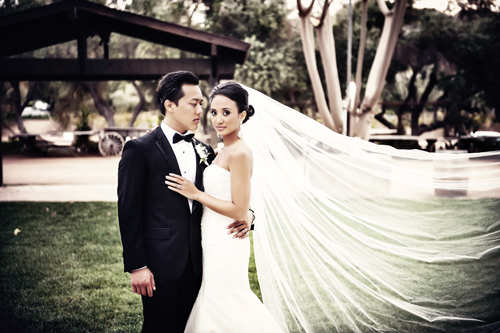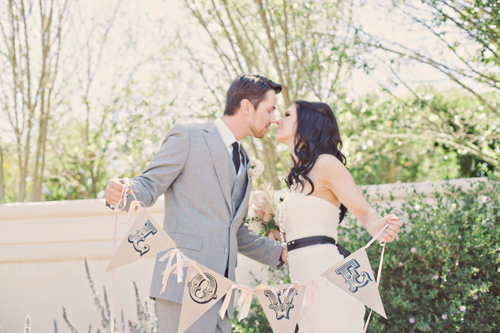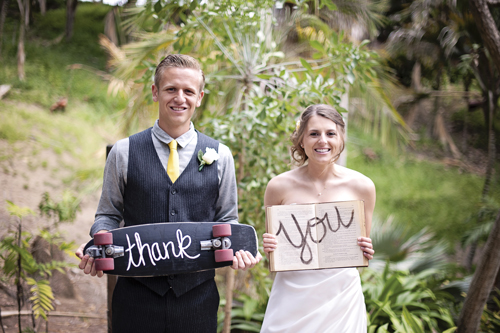The 411 on Wedding Photography Jargon
By: Kristen Castillo
It seems like everything in life, including weddings has lingo. There’s B2B (Bride to Be), MOH (Maid of Honor) and G2B (Groom to Be). But do you know what your photographer means when he or she asks if you want a “first look,” a “flush mount” or a “mini boudoir”? Probably not, which is why we asked some San Diego and Temecula wedding photographers to share their insight into bridal photography jargon.

BEFORE THE WEDDING
E-Session
These photo sessions are formally called engagement sessions during which you and your guy pose for shots of you as a couple.
These sessions are great for a few reasons: 1) you get professional images of you and your guy for your use in things like photo albums, save the dates, social media and of course to frame and display at home and at work; and 2) this session gives you the chance to work with your photographer before the wedding day, which ensures you’ll get to know each other better and therefore will be comfortable working together throughout your big day.

AT THE WEDDING
Mini Boudoir
This sexy photo session is done on the actual wedding day after the bride has had her hair and makeup done. There’s no nudity, just sensuality.
“Minutes before she sees her groom, we take her off to the side and do some window silhouette shots or on the bed in the hotel room,” says Stephanie Sundell of Creative Photography Inc. by Stephanie, who calls the mini boudoir photos, a “surprise for later!”
First Look
It’s not necessarily bad luck for the groom to see his bride before the wedding. The first look is “where the bride and groom get to see each other before the ceremony, often set up to be very private and romantic,” says Chris Austin of White Haute Photography. “This is an up-and-coming, and highly recommended, trend that couples should seriously consider as it allows more time for photos, more time to socialize with your guests at the cocktail reception, and less stress overall.”
Formals and Family Photos
Even couples who want un-posed pictures, typically want these traditional wedding images.
“These are posed pictures taken either before or after the ceremony,” says Holly Ireland of Holly Ireland Photography, noting the photos often capture the couple with each other’s parents, siblings and other family members.
Second Shooter
This is a second photographer “who will also be photographing the wedding, normally hired by the photographer for four to six hours,” explains Shayna San Nicolas of Mr. & Mrs. {A Video & Photography Dou}.
A second shooter isn’t always necessary but they’re a great help to the primary photographer, making sure all the details are photographed.
“The second shooter is there to capture all the candid moments and shots from other angles to create the full story of the day,” says Ireland.
Forehead Snuggle
Just as it sounds, this term is all about getting the couple to move in close to each other. “Used just for posing and it’s just us I believe that use it,” says Adriana Rodriguez of Love Art Photography. “Either way it always gets the point across and the couple always cracks up.”
Uncle Charlie
This photo jargon isn’t about a specific member of your family. Instead it refers to “any family member with amateur video camera that thinks he owns the show” says Sundell.
Not surprisingly, Uncle Charlie (or “Uncle Bob” or “Aunt Betty” as this person is also known) typically gets in the professional photographer’s way.
Detail Shots
“These are the photos of all the details you spend money on,” says Ireland.
Your photographer will capture all the special elements of your wedding day such as close ups of your flowers, rings, your gown and shoes, your guest book, the food and favors.
Bogie
Referring to a person in the background, bogies are best avoided whenever possible. Otherwise, the photographer will have to remove that person out of the photo during postproduction.
Drag the Shutter
This technique, which you often see on Pinterest and wedding blogs, is typically used during nighttime photography. As Austin explains, it’s “where a slow shutter speed is used in conjunction with flash to stop the action and freeze motion while still allowing more of the ambient light to get into the photo.”
He says dragging the shutter is “especially helpful during dancing, where you can get sharp images while the lights of the reception glow or ‘streak’ across the photo.”
Eat and Run
A term most popular with photographers, videographers, DJs and other on-site wedding vendors, “Eat and Run” refers to when a vendor’s meal break is very short, typically after all the guests have been served.
“If you want to keep your photographer and videographer happy, check to see if your coordinator or caterer can serve the vendor meals while your other guests are eating,” suggests Austin.

AFTER THE WEDDING
Editing
This is the process of narrowing down a large number of images.
“A wedding may have 3000 images,” says Aaron Feldman, CEO and founder of True Photography. “But many of those pictures taken are test shots. Or there may be 10 dancing shots, to get the best two or three images.
“Editing is important so that the viewer is not having to look at repeat images or unflattering images. Instead they see the finished product.”
Feldman explains an editor needs to know the flow of the images so an important photo doesn’t get overlooked.
“The formula is to edit enough so that the images are more powerful and interesting, but not too much where moments are lost,” he says.
Trash the Dress
These photo sessions, which can happen any time after the wedding, are all about ruining the bride’s dress for the sake of great photography. For example, the bride may run in the ocean, wetting the gown; she may paint in the dress, allowing paint drips as they happen; or she and her husband may stand in the rain, stomping through puddles of mud.
Day After Session
These sessions are similar to “Trash the Dress” but they’re “not meant to ruin or destroy the wedding dress,” says Austin, explaining day after sessions are “meant for couples who didn’t get enough time for photos on their wedding day and want to take pictures at a more unique location and don’t want to feel nervous about getting the dress a little dirtier.”
Sneaks
These are a preview of the photos your photographer shot at your wedding. Often a few photos are posted to the photographer’s blog and/or their Facebook page, tagging the bride and groom when possible.
Digital Negatives
Presented on a disc or flash drive, the “negatives are exactly how the image was shot,” says Ireland. “So no retouching or cropping.”
Digital negatives “can be printed at the lab of your choice,” says San Nicolas.
Post
This term refers to after-the-shoot editing using Photoshop. Sundell says post accounts for “about 40 percent of the job.”
Enhancement
This term is about an image’s styling such as boosting an image’s color, choosing black and white or color and even darkening an image’s corners.
“We go image by image and individually enhance every photo,” says Feldman. “We have in house exclusive enhancers, which makes our style truly one of a kind. This is included as part of our process at no extra cost. We want to make sure that the images we put out have that finished look that fits the style of what we do.”
Actions
Sundell describes this photo lingo as a “special way we retouch the photo with layers of Photoshop expertise.”
Retouching
When a photo is retouched, the photographer or editor is “adding or taking away something from the image that didn’t exist” in the original photo, says Feldman.
Examples of retouching include removing blemishes, covering a trashcan with a plant, thinning the subject of the photo and even moving a smile from one image to another.
“Those are all things that are much more labor intensive and should be done to the images that you care about most, such as in a wedding album,” says Feldman, noting most clients don’t want a lot of retouching since “so much of the feel gets accomplished within the enhancement.”
Flush Mount Album
“A flush-mount album is a contemporary alternative to a traditional matted wedding album,” says Ireland, explaining each page is a “borderless photographic print that can include multiple images and backgrounds.”
These albums, which are also known as magazine style albums, are hand crafted and feature thick lay-flat pages.
Parent’s Album
Known as a Mother’s Album or a Parent’s, this album features wedding day images for the parents of the bride and groom. A “great gift idea,” says San Nicolas.